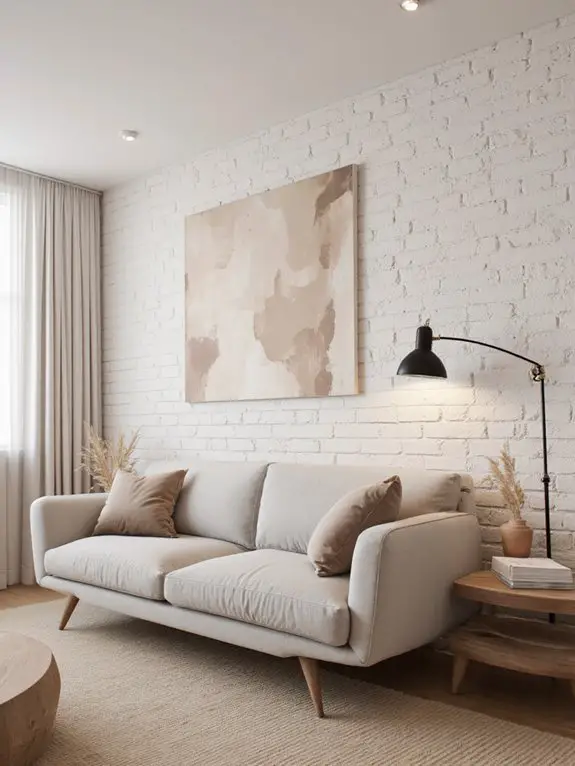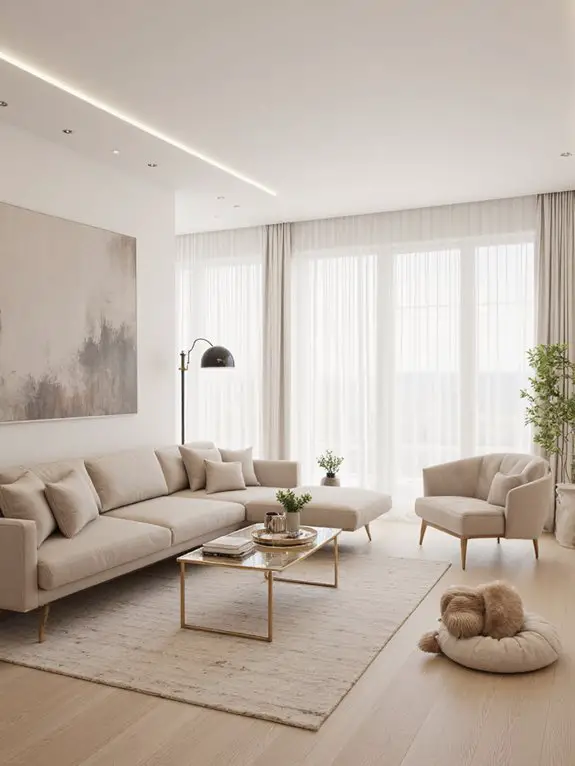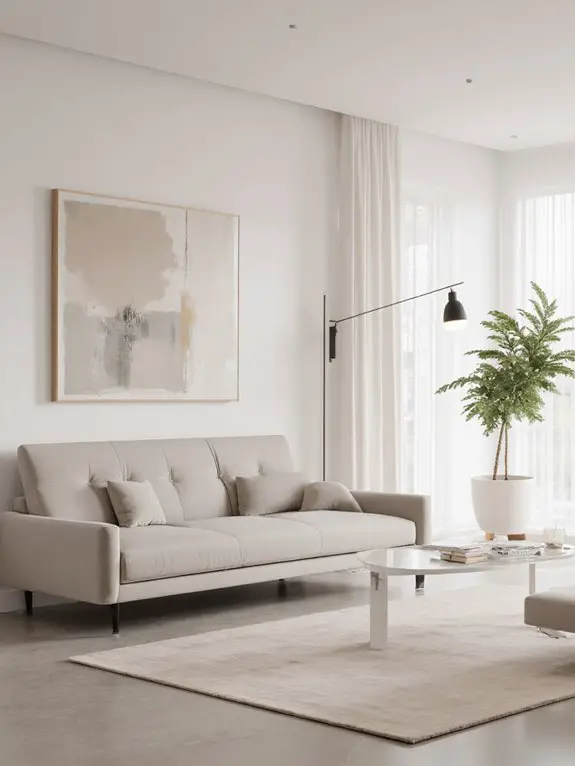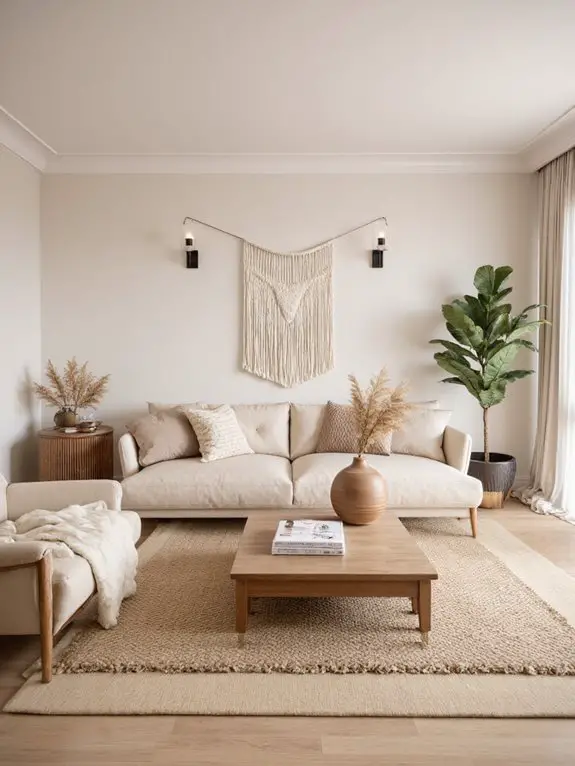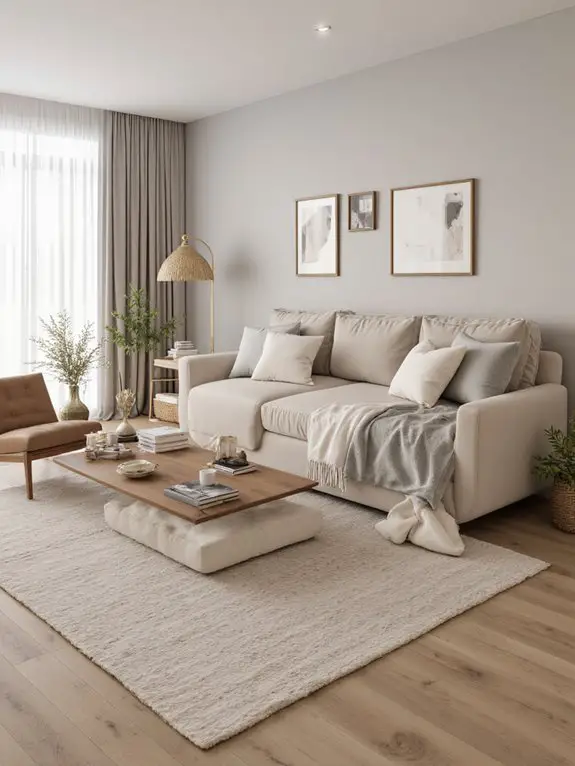I start with a neutral color palette like beige or gray to create a calming backdrop. Sheer curtains let in natural light while softening the room’s look. I arrange minimalist, multifunctional furniture to maximize space and flow. A statement rug adds texture and defines seating areas. Wall shelves serve as both storage and decor, keeping clutter at bay. Hanging curtains high makes ceilings feel taller. Keeping electronics minimal guarantees clean lines. There’s more to explore for a complete transformation.
Neutral Color Palette for a Calming Effect
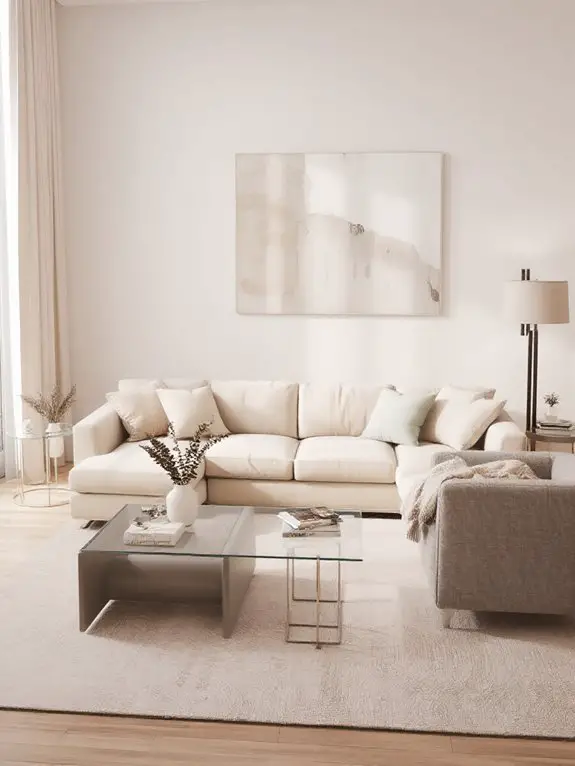
When I’m designing a living room, I always emphasize the importance of a neutral color palette because it creates a sense of calm and timelessness. Shades like beige, gray, and soft whites serve as a versatile backdrop, allowing furniture and decor to stand out without overwhelming the space.
Neutrals also make it easy to switch up accents seasonally without a full redesign. I recommend layering textures—think linen sofas, wool rugs, and wooden coffee tables—to add depth.
This approach guarantees a cohesive, inviting atmosphere that feels both modern and enduring, perfect for relaxing or entertaining.
Incorporate Natural Light With Sheer Curtains
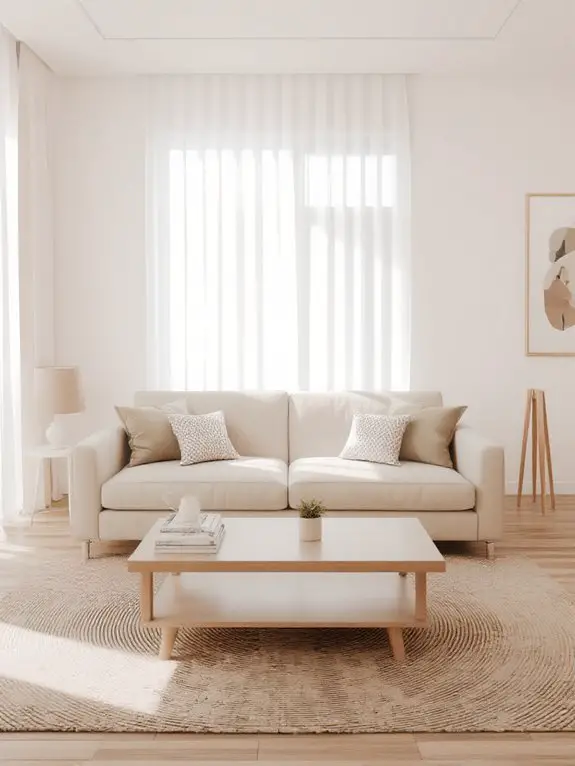
Building on the foundation of a neutral color palette, I find that maximizing natural light is key to enhancing the calming and timeless feel of a living room. One of my favorite tricks is using sheer curtains—they let sunlight pour in while softening its intensity.
I opt for light, neutral-toned sheers that blend seamlessly with the walls, maintaining a cohesive look. They also add a touch of elegance without overwhelming the space.
For practicality, I layer them with blinds or thicker drapes for versatility in controlling light and privacy. This simple addition makes the room feel airy, inviting, and uplifting.
Minimalist Furniture Arrangement
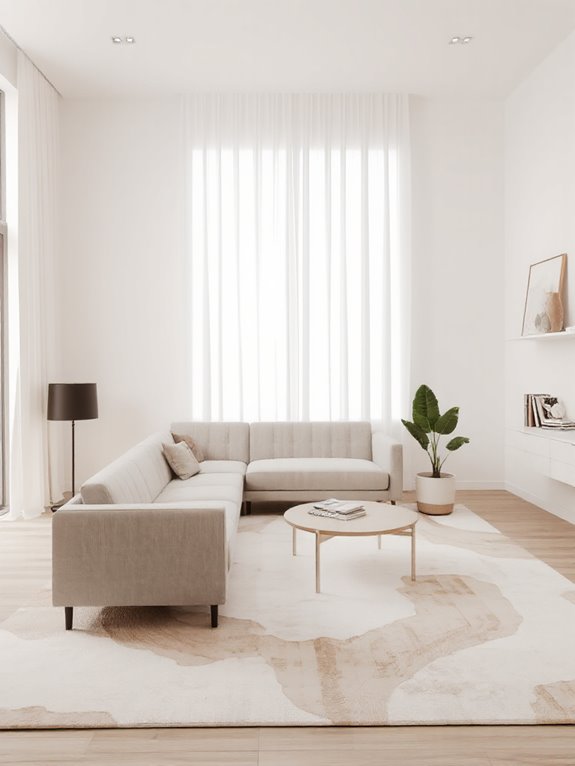
While natural light sets the tone for a serene living room, carefully selecting and arranging minimalist furniture can elevate the space’s functionality and aesthetic.
I start by choosing a few key pieces—like a streamlined sofa and a sleek coffee table—that serve both purpose and style. Keeping furniture low-profile and spaced apart creates an open feel. I avoid overcrowding, letting each piece breathe.
Neutral tones and clean lines maintain harmony, while multifunctional items, like ottomans with storage, maximize utility. By focusing on balance and simplicity, the room feels uncluttered yet inviting. Less truly becomes more in a minimalist setup.
Add a Statement Rug for Visual Interest
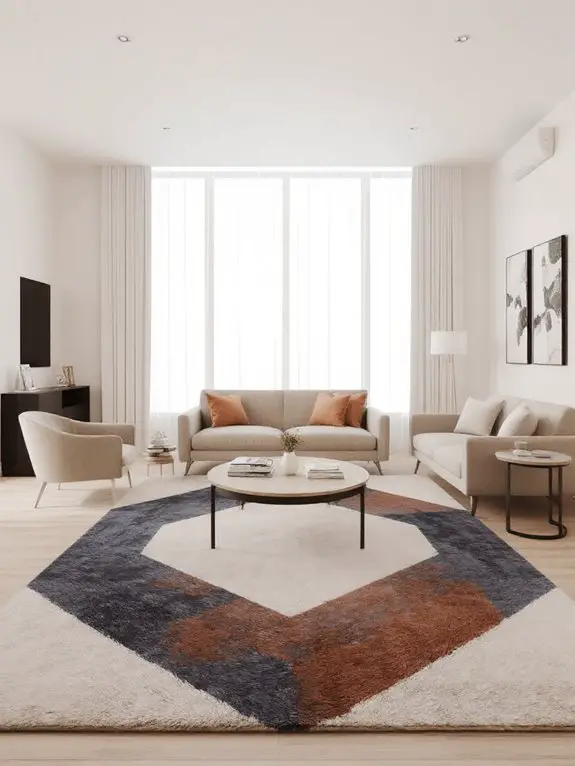
To anchor the minimalist vibe while adding depth and texture, I incorporate a statement rug that complements the room’s aesthetic. I choose a rug with clean lines or subtle patterns to avoid overwhelming the space. Neutral tones or muted colors work well, but I sometimes opt for a bold hue to create a focal point.
The material matters too—wool or jute adds warmth and durability, while softer textures like cotton enhance comfort. I make certain the rug is large enough to fit under the front legs of furniture, tying the seating area together cohesively. This simple addition elevates the room’s visual appeal effortlessly.
Use Wall Shelves for Functional Decor
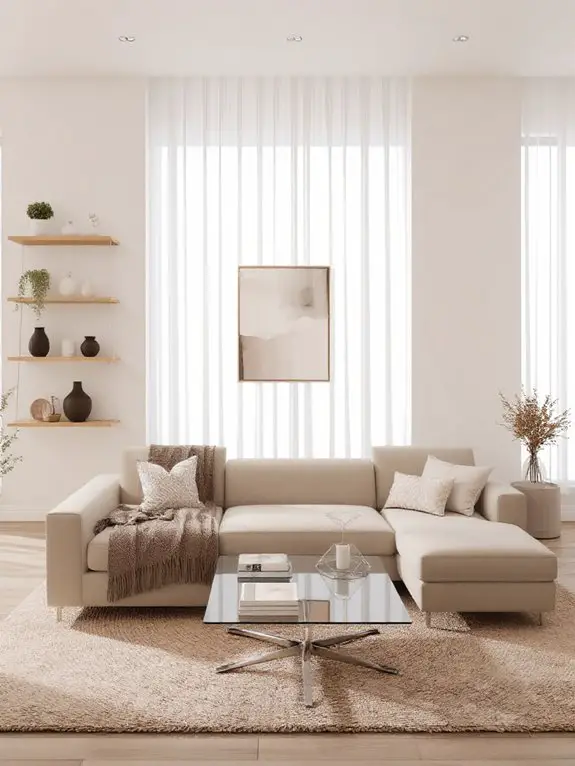
When designing a living room, wall shelves can serve as both functional storage and decorative elements that enhance the space. I love how they maximize vertical areas without cluttering the floor, making the room feel open and organized.
I use them to display books, plants, or small decor pieces, adding personality and texture. Floating shelves are my go-to for a sleek, modern look, while wooden or rustic styles bring warmth.
I always measure the wall space beforehand to make sure they fit proportionally. Arranging items in groups of three or five creates balance, and layering objects adds depth without overwhelming the eye.
Opt for Multi-Functional Furniture
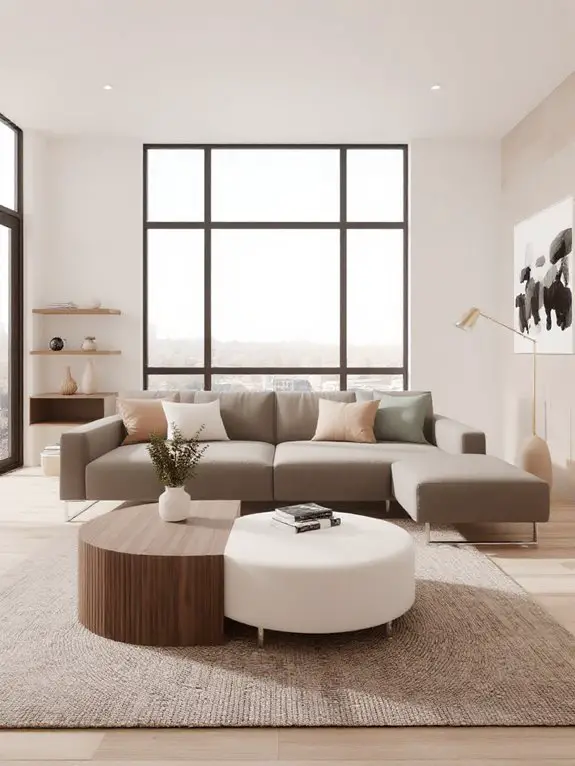
Multi-functional furniture is a game-changer for living rooms, especially when space is limited. I love pieces like ottomans with hidden storage or sofa beds that transform for guests.
A coffee table with built-in shelves keeps clutter out of sight while serving its main purpose. Nesting tables are perfect for small spaces—they tuck away when not in use.
Look for TV stands with drawers or cabinets to stash remotes and cords. Modular sectionals let you rearrange seating as needed.
Investing in versatile furniture means my living room stays stylish and practical without feeling cramped. It’s all about maximizing function without sacrificing comfort.
Layer Pillows and Throws for Coziness
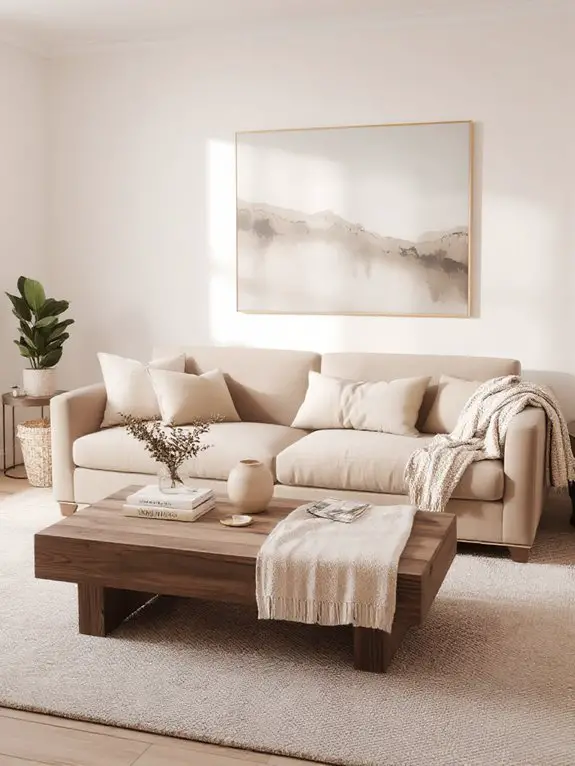
Though it might seem simple, layering pillows and throws instantly transforms a living room into a cozy retreat. I start with a mix of sizes—large floor pillows, standard couch cushions, and smaller accent pieces—to create depth.
Textures matter too; I pair chunky knits with smooth velvet or linen for contrast. A well-placed throw draped over the armrest invites relaxation. Stick to a cohesive color palette, but don’t shy away from subtle patterns for interest.
The key is balance—too many layers feel cluttered, while too few lack warmth. It’s an effortless way to elevate comfort without overwhelming the space.
Create a Focal Point With Artwork
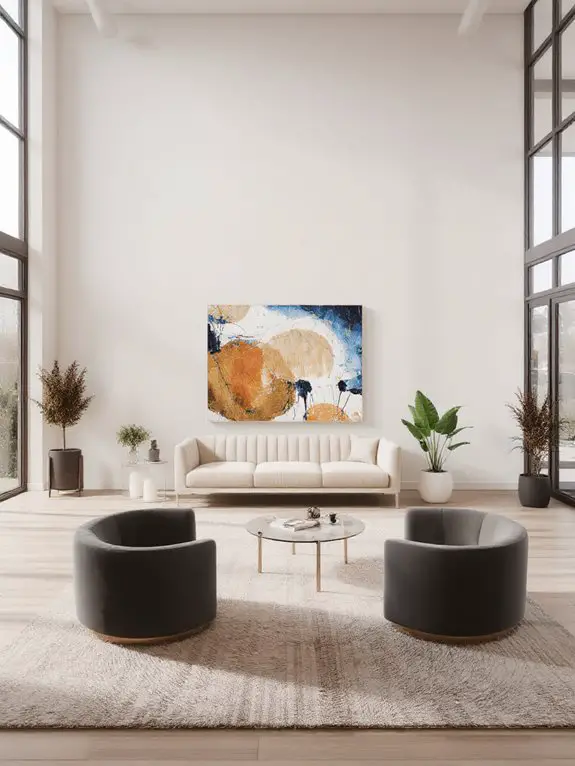
To make a statement in a living room, I always start by selecting a standout piece of artwork as the focal point. It could be a large painting, a striking photograph, or even a sculptural piece.
I position it above the sofa or on a prominent wall to draw the eye immediately. I guarantee it complements the room’s color palette and style, whether modern, traditional, or eclectic.
Lighting is key—I use a picture light or nearby lamps to highlight its details. A well-chosen artwork not only personalizes the space but also sets the tone for the entire room’s design.
Introduce Indoor Plants for Freshness
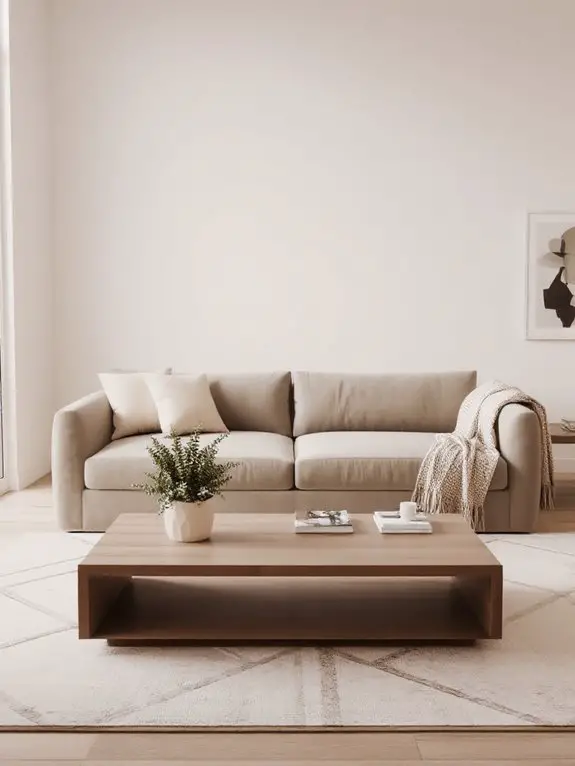
Indoor plants bring life and vibrancy to a living room, transforming it into a fresher, more inviting space. I love how they add a natural touch, making the area feel more alive and calming.
I’d suggest selecting low-maintenance options like pothos, snake plants, or ZZ plants if you’re new to plant care. Place them in corners, on side tables, or even hang them to create visual interest. They also improve air quality, which is a bonus.
I always recommend matching the pots to your decor for a cohesive look. Plants are an effortless way to elevate your living room’s ambiance.
Choose a Sleeper Sofa for Added Functionality
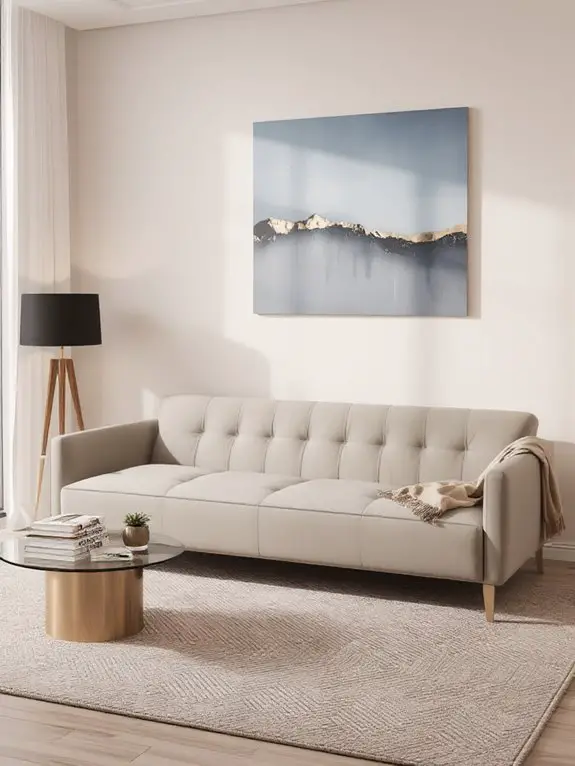
When space is limited but versatility is key, a sleeper sofa can be a game-changer for your living room. I’ve found that choosing one with a comfortable mattress guarantees it doubles as a cozy guest bed. Look for designs with easy-to-use mechanisms and durable upholstery to withstand frequent use.
A sleek, compact style keeps the room feeling open while adding functionality. I recommend neutral tones to match any décor, but don’t shy away from bold colors if it suits your aesthetic.
Ultimately, a sleeper sofa maximizes your space without sacrificing comfort, making it a practical and stylish addition to any home.
Hang Mirrors to Enhance Space
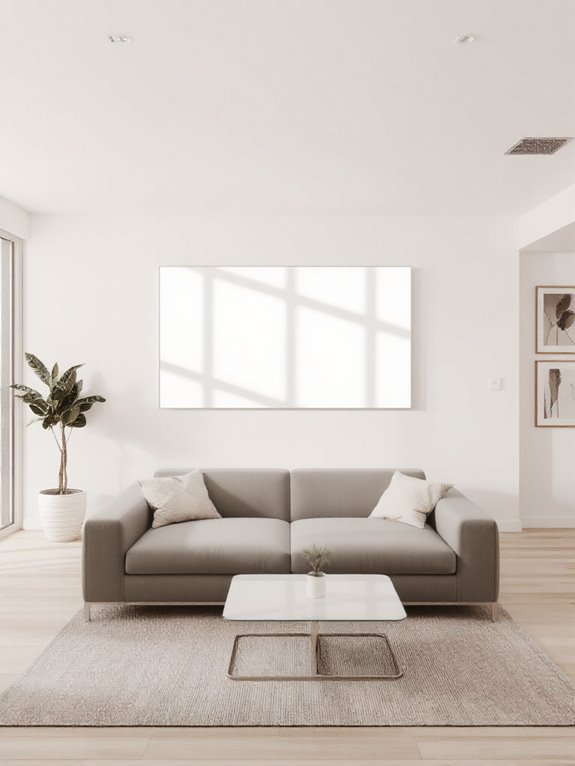
If you’re looking to make your living room feel more expansive, I’ve found that strategically hanging mirrors can work wonders. Positioning a large mirror opposite a window reflects natural light, instantly brightening the room and creating a sense of openness.
I also recommend using an oversized mirror as a focal point above a sofa or fireplace to draw the eye and add depth. For smaller spaces, grouping smaller mirrors in asymmetrical arrangements can achieve a similar effect.
Avoid cluttering the room with too many mirrors; one or two well-placed pieces can make a significant difference in enhancing the space.
Use Accent Lighting for Ambiance
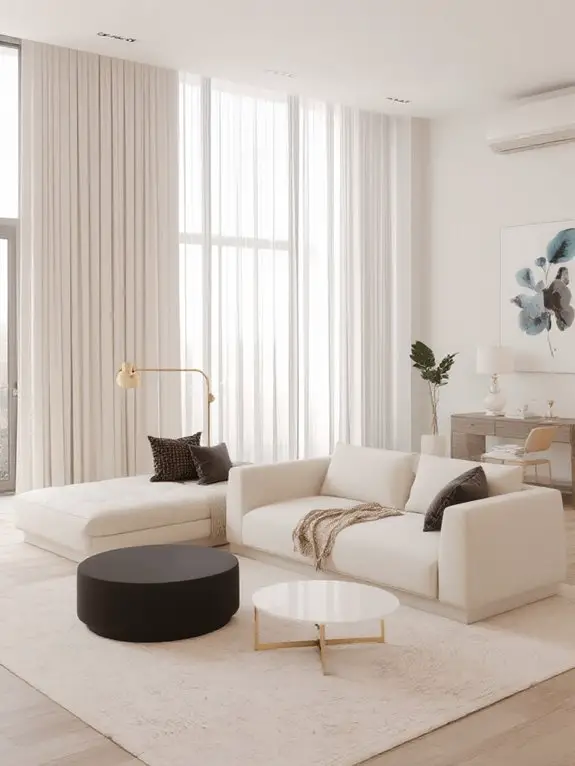
To create a warm and inviting atmosphere in your living room, I’ve found that accent lighting is an essential tool. Instead of relying solely on overhead lights, I use table lamps, floor lamps, or wall sconces to add depth and warmth.
Positioning lights near artwork, plants, or architectural features highlights these elements and draws the eye. I also recommend dimmable lights to adjust the mood for different occasions.
LED strip lights under shelves or behind furniture can create a modern, cozy glow. By layering light sources, I transform my space into a comfortable retreat that feels both stylish and welcoming.
Declutter With Hidden Storage Solutions
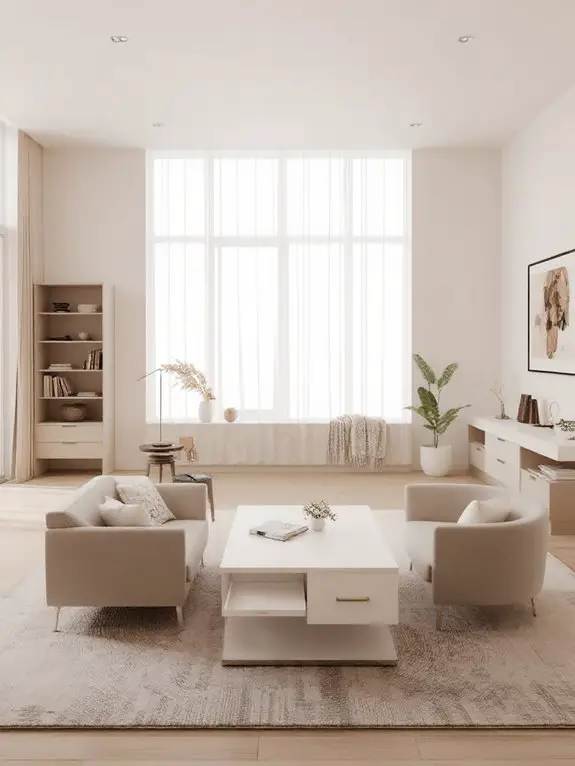
In keeping a living room both stylish and functional, I’ve discovered that hidden storage solutions are key to maintaining a clutter-free space. Built-in cabinets or shelves with concealed compartments can keep books, toys, or electronics out of sight while adding to the room’s design.
I love using ottomans or coffee tables with lift-top storage for blankets, remotes, or magazines. Floating shelves with decorative baskets are another practical option for organizing smaller items. Even the space under sofas can be utilized with slim, pull-out drawers.
Mix Textures for Depth and Warmth
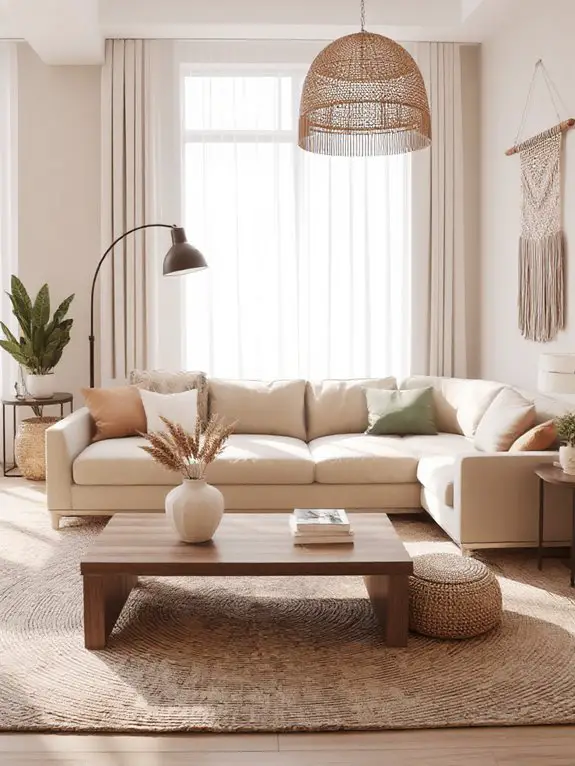
Layering different textures in a living room can instantly elevate its visual appeal and create a sense of warmth and depth. I love combining materials like plush rugs, smooth leather, and linen throw pillows to add dimension.
A knitted blanket draped over a sleek sofa softens the look, while a woven basket or rustic wood accent brings in natural charm. Don’t shy away from mixing metals—they can add subtle contrast.
Even fabrics with varied patterns, like velvet and cotton, can coexist harmoniously. By blending textures thoughtfully, you’ll create a space that feels inviting and visually interesting without overwhelming the eye.
Display Collections as Decor Pieces
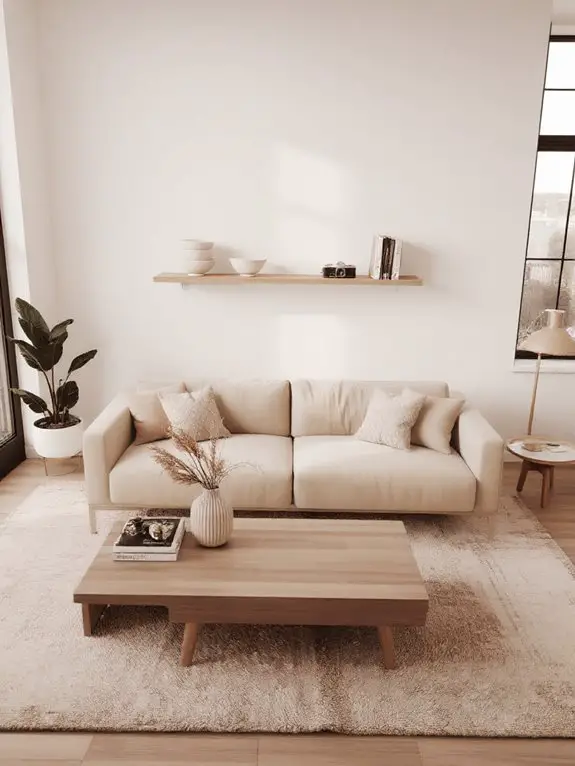
Collections aren’t just personal treasures—they’re meaningful decor elements that can define a space. I love incorporating items like vintage books, ceramic vessels, or travel souvenirs into my living room to reflect my personality.
Grouping similar pieces together creates visual impact—think a cluster of framed photos, a shelf of figurines, or a wall of woven baskets. To avoid clutter, I limit the display to one or two collections, ensuring they complement the room’s overall aesthetic.
I also play with arrangement heights and spacing for balance. By thoughtfully showcasing what I cherish, I turn my living room into a curated, inviting space that tells my story.
Experiment With a Monochrome Theme
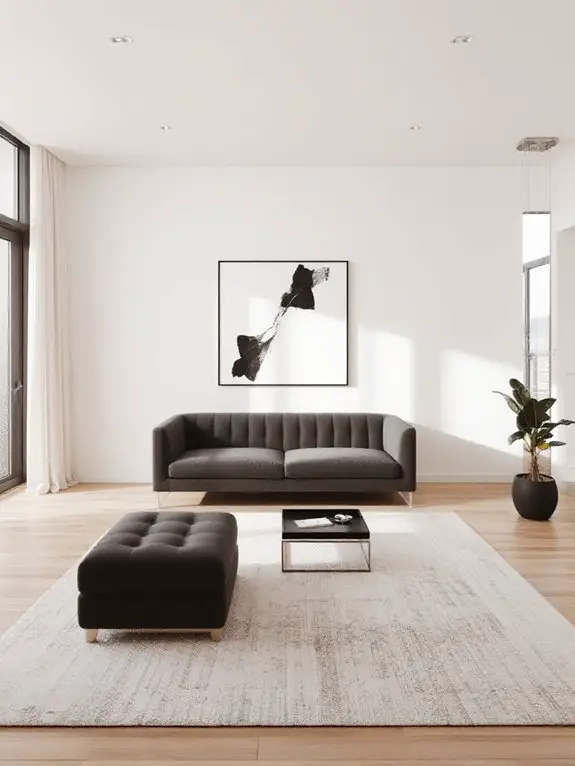
Experimenting with a monochrome theme can instantly elevate your living room’s sophistication and cohesion. I find sticking to a single color palette simplifies decision-making while creating a sleek, unified look.
Start with walls and furniture in varying shades of your chosen hue—be it gray, blue, or even beige. Layering textures, like a plush rug or velvet cushions, adds depth without breaking the theme.
I also recommend mixing materials, such as wood and metal, to keep the space dynamic. Lighting plays a key role too; opt for soft, ambient fixtures to enhance the room’s serene, harmonious feel.
Add a Pop of Color With Accessories
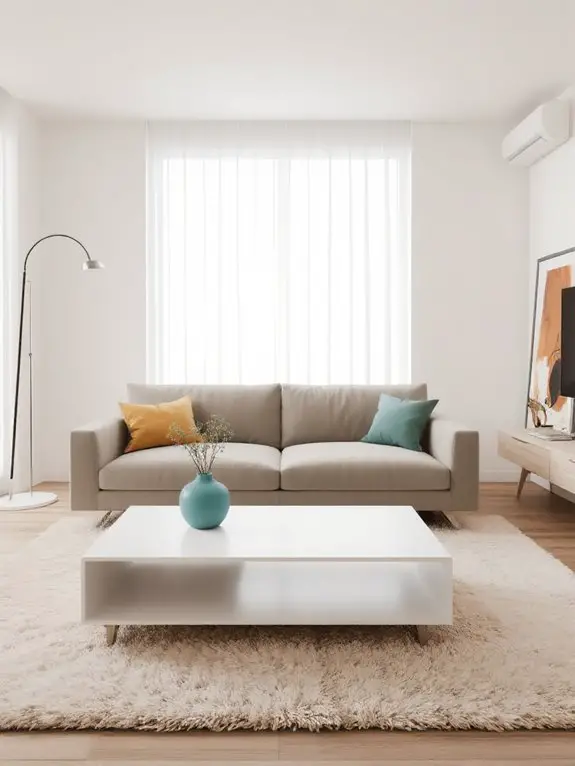
A vibrant throw pillow or a bold piece of artwork can transform a monochrome living room into a space that feels lively and intentional. I often choose accessories in colors that complement the room’s base tones while adding contrast. For example, a mustard yellow vase or a teal rug can draw the eye without overwhelming the space.
I keep the palette cohesive by limiting myself to two or three accent colors. Layering textures, like a velvet cushion or a ceramic sculpture, also enhances the visual impact.
These small, thoughtful touches make the room feel curated and inviting without requiring a complete overhaul.
Incorporate Geometric Patterns for Modernity
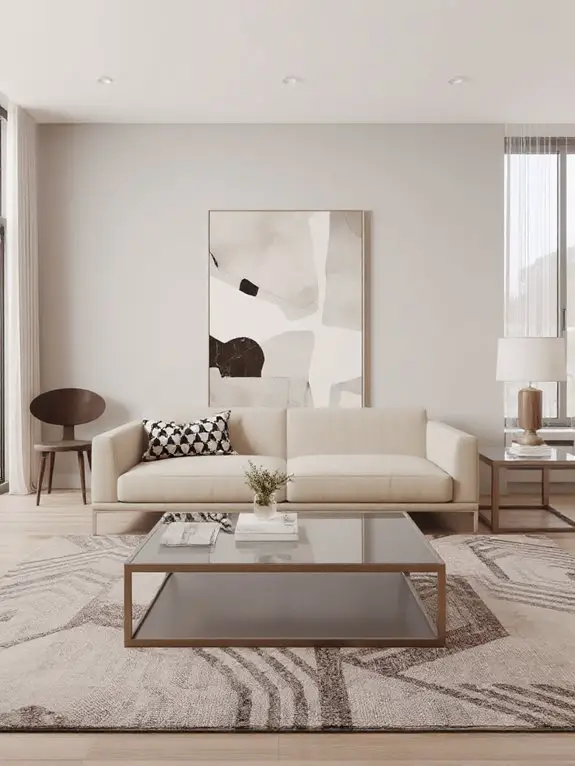
Geometric patterns can instantly elevate the modernity of a living room by introducing structure and visual interest. I love using them to create a dynamic yet cohesive look.
Start with a geometric area rug to anchor the space—it’s a subtle way to add sophistication. Throw pillows with angular designs or striped patterns can complement the rug without overwhelming the room.
For a bolder statement, consider a geometric wallpaper accent wall or artwork with clean lines. The key is balance; I pair these patterns with solid-colored furniture to keep the space from feeling chaotic.
Geometric decor, like hexagonal shelves or triangular lamps, adds a finishing touch.
Use Open Shelving for Display
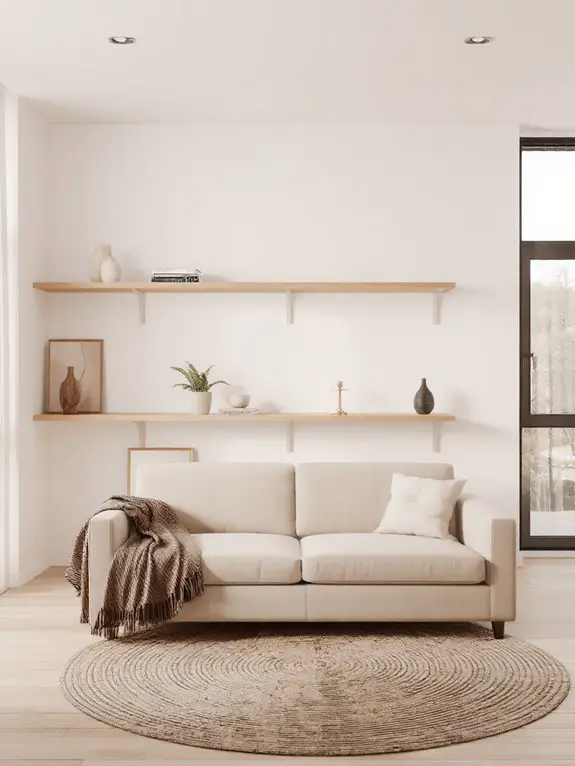
Open shelving offers a versatile way to showcase your personality while keeping your living room functional. I love how it allows me to display meaningful items like books, plants, and decorative pieces in an organized yet stylish way.
To avoid clutter, I arrange items in small groupings, balancing taller objects with shorter ones for visual interest. Staggering items rather than lining them up rigidly creates a more dynamic look.
I also mix textures and materials, like pairing ceramic vases with wooden bowls, to add depth. Open shelving keeps essentials within reach while doubling as a focal point that sparks conversation.
Opt for Light Wood Finishes for a Bright Look
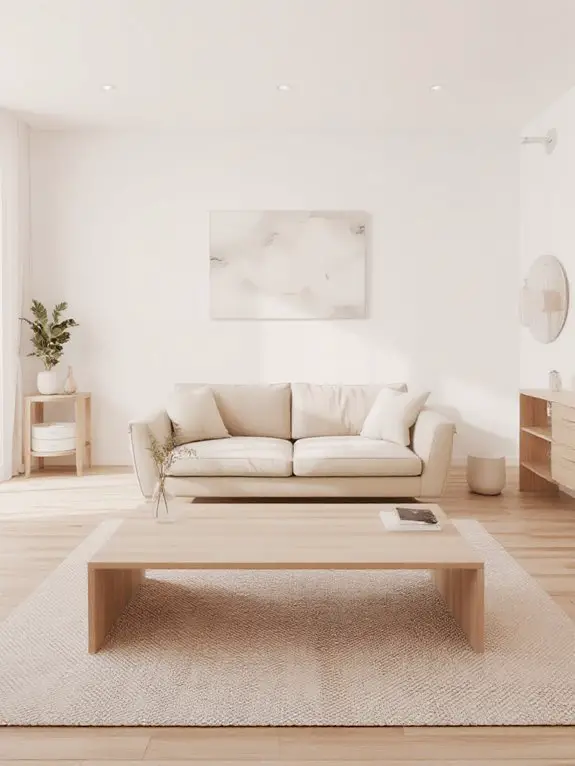
Light wood finishes can instantly transform your living room, creating an airy and inviting atmosphere. I love how they reflect natural light, making the space feel larger and more open. Opting for oak, maple, or ash in your furniture or flooring adds warmth without overwhelming the room.
Pairing light wood with neutral tones like beige or white enhances the brightness, while adding a few pops of color keeps it lively. I also recommend mixing textures—like a light wood coffee table with a soft, woven rug—to add depth.
It’s an effortless way to achieve a modern yet timeless look that feels fresh and welcoming.
Blend Vintage and Contemporary Styles
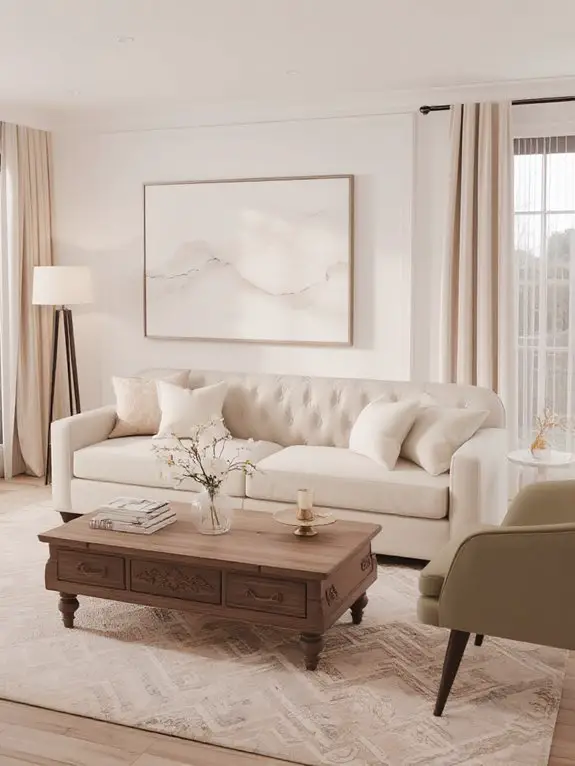
While light wood finishes bring brightness to a space, blending vintage and contemporary styles adds character and depth to your living room. Start by pairing a sleek, modern sofa with a rustic wooden coffee table or an antique sideboard.
I’ve found that mixing textures, like a velvet cushion on a mid-century chair, creates visual interest. Don’t be afraid to incorporate vintage artwork or a retro lamp into a minimalist setup.
Balance is key—too much of one style can overwhelm. By thoughtfully combining eras, you’ll craft a space that feels timeless, personal, and effortlessly stylish.
Create a Cozy Reading Nook
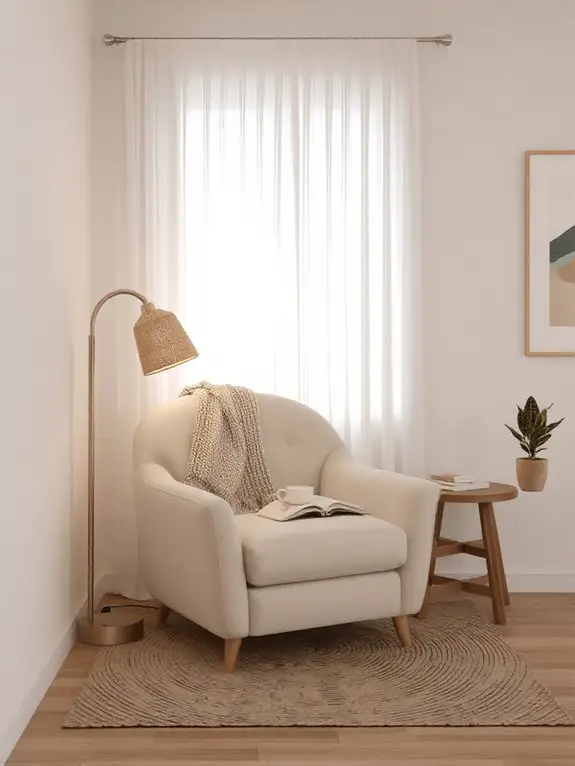
To carve out a cozy reading nook in your living room, start by selecting a quiet corner that feels naturally inviting. I’d place a comfortable armchair or a small loveseat there, ensuring it’s soft but supportive for long reading sessions.
Add a side table for your books and a warm lamp to create ambient lighting. A plush throw blanket and a few cushions will make it even cozier.
If space allows, a small bookshelf nearby keeps your favorites within reach. The key is to make it feel secluded yet part of the room, so you’ll actually use it.
Hang Curtains High to Elevate Ceilings
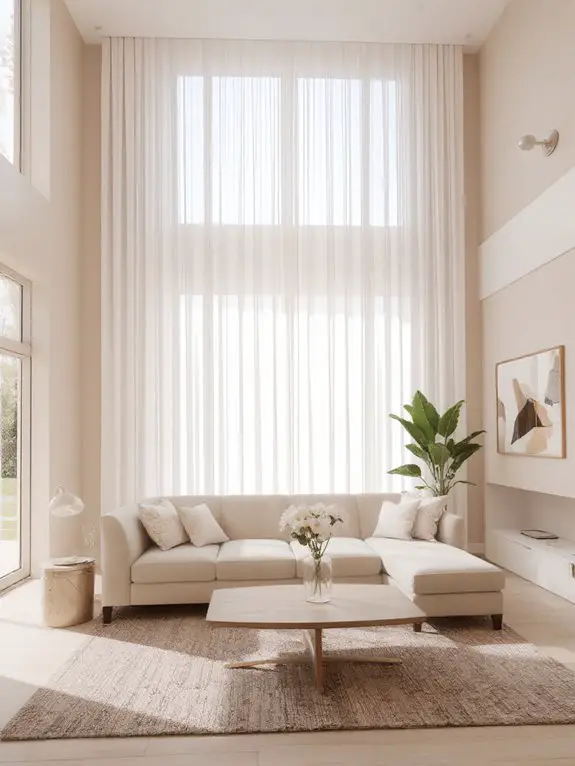
After creating a cozy reading nook, I’d turn my attention to another simple yet impactful design trick: hanging curtains higher than the window frame. Placing the rod four to six inches above the window creates the illusion of taller ceilings, making the room feel more spacious and airy.
I’d choose floor-to-ceiling curtains to emphasize this effect, ensuring they graze or slightly puddle on the floor for an elegant touch. Opting for lightweight fabrics in neutral tones can amplify natural light, while heavier materials add warmth and drama.
This small adjustment transforms the room’s proportions without a major overhaul.
Use Area Rugs to Define Zones
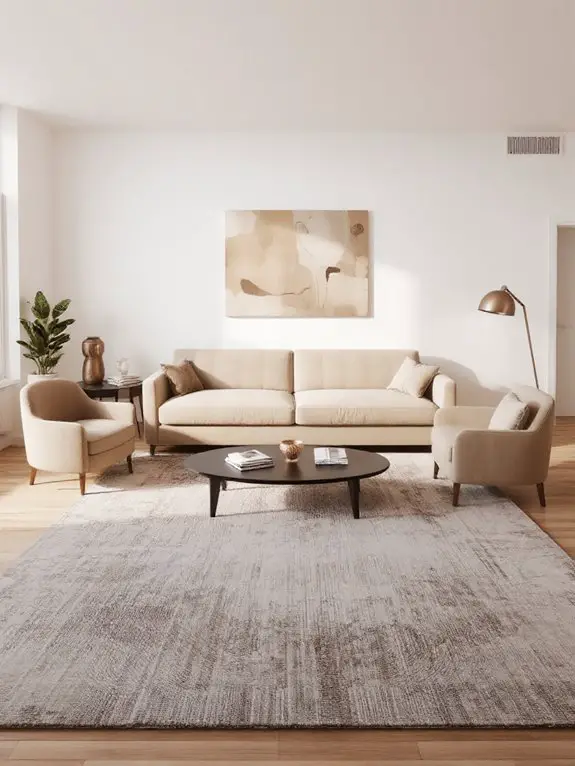
When I’m looking to define distinct areas in a living room, I find that area rugs are one of the most effective tools for creating visual and functional zones. By placing a rug under a sofa and chairs, I can instantly establish a cozy seating area.
For smaller spaces, I opt for rugs with bold patterns to anchor the furniture and draw the eye. In open-concept layouts, I use contrasting rugs to separate the living room from adjacent spaces like dining or reading nooks.
It’s a simple yet impactful way to add structure and warmth without overwhelming the design.
Keep Electronics Minimal for Clean Lines
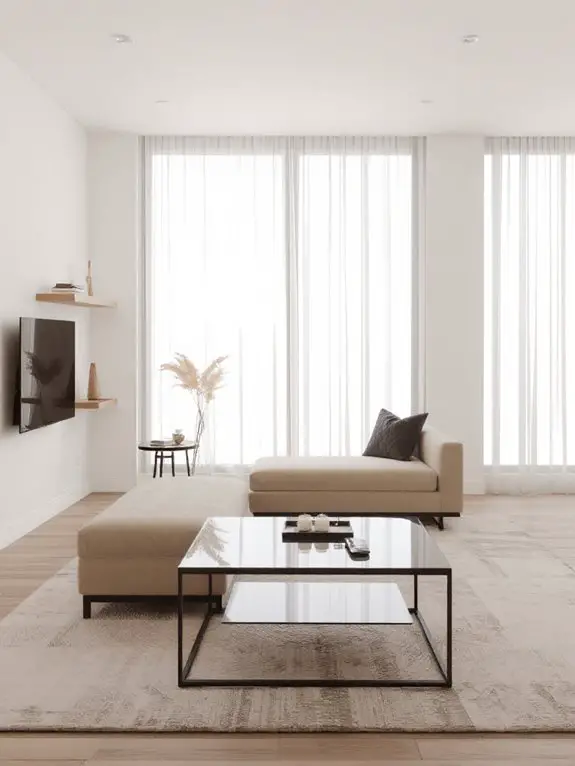
Minimizing electronics in the living room creates a sleek, uncluttered look that enhances the overall design. I focus on integrating essentials like a TV or sound system subtly, using built-in cabinetry or wall mounts to reduce visual clutter. Opt for wireless speakers and smart tech to eliminate tangled cords.
I also limit gadgets to only what’s necessary, avoiding excess that disrupts the room’s flow. Concealing remotes or chargers in stylish storage boxes keeps surfaces tidy. By prioritizing simplicity, the space feels more inviting and less chaotic, allowing the design and decor to shine without distractions.
Frequently Asked Questions
How Do I Choose the Right Sofa Size?
I’ll need a sofa that feels like it could fit the entire neighborhood, but realistically, I’ll measure my space first, considering room for walking paths and ensuring it complements the room’s proportions without overwhelming it.
What Lighting Fixtures Work Best in a Small Living Room?
I’d suggest wall sconces or pendant lights for a small living room since they save floor space. A floor lamp with an adjustable arm can spotlight areas, while recessed lighting keeps the ceiling clean and open.
Can I Mix Different Wood Tones in My Living Room?
I often wonder if mixing wood tones in my living room works. I’ve found that combining light and dark woods adds depth and warmth, as long as I balance them with neutral pieces or a unifying color palette.
How Do I Arrange Furniture in an Oddly Shaped Room?
I’d start by measuring the room and sketching a layout. I’ll place the largest piece first, like a sofa or sectional, to anchor the space. Then, I’ll arrange smaller pieces to create flow and balance, avoiding clutter.
What Are Budget-Friendly Living Room Decor Ideas?
I’ll add personality with DIY art, I’ll mix textures with thrifted throws, I’ll brighten the space with affordable LED string lights, and I’ll layer rugs for warmth. Breathe new life into the room without breaking the bank.

